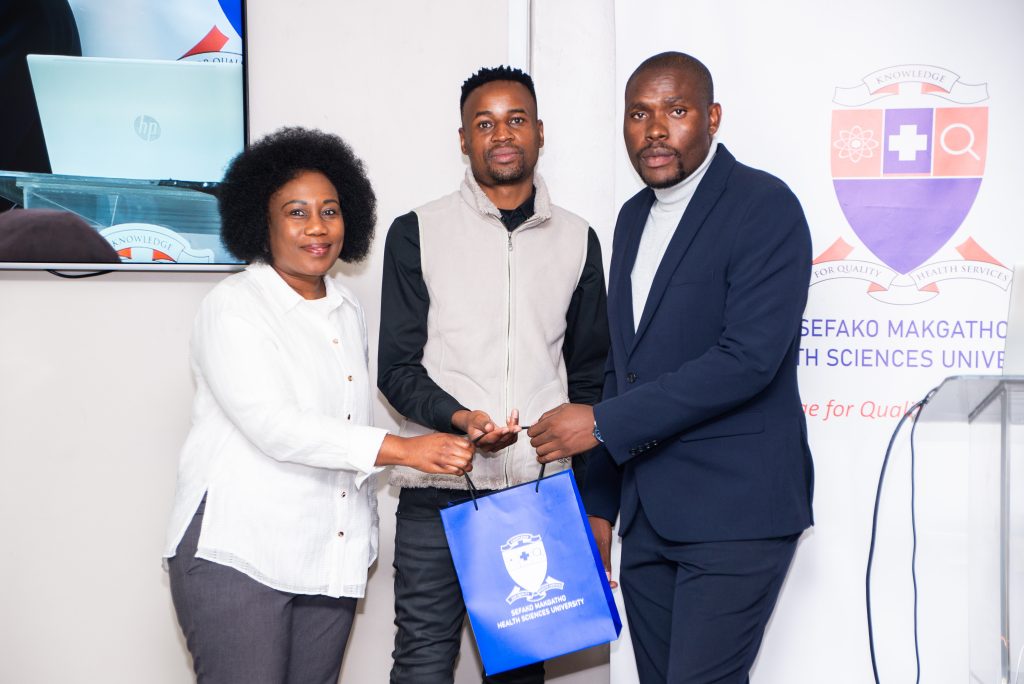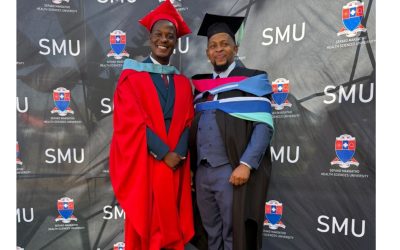Sefako Makgatho Health Sciences University (SMU) joined the global stage in celebrating World Intellectual Property (IP) Day 2025, embracing this year’s theme, “Intellectual Property and Music – Feel the Beat”, with an inspiring showcase of local talent, innovation, and powerful dialogue.
 Through its Technology Transfer Office (TTO), in collaboration with the National Intellectual Property Management Office (NIPMO), SMU hosted a vibrant event that highlighted the critical role of IP in the creative economy, particularly in music, and its potential to drive transformation, empowerment, and economic growth. The celebration not only amplified awareness around IP rights but also spotlighted the intersection between artistic expression and scientific ingenuity within the SMU community.
Through its Technology Transfer Office (TTO), in collaboration with the National Intellectual Property Management Office (NIPMO), SMU hosted a vibrant event that highlighted the critical role of IP in the creative economy, particularly in music, and its potential to drive transformation, empowerment, and economic growth. The celebration not only amplified awareness around IP rights but also spotlighted the intersection between artistic expression and scientific ingenuity within the SMU community.
The event brought together inventors, academics, legal experts, students, and other stakeholders in the innovation ecosystem to reflect on the role of intellectual property in stimulating creativity, safeguarding ideas, and contributing to economic development, particularly within the spheres of academia, music, and indigenous knowledge systems.
Delivering the opening address, Professor Mapaseka Seheri, SMU’s Director of Research and Innovation, warmly welcomed delegates and emphasised the transformative power of innovation.
“Innovation makes the world work better,” she said. “At SMU, we believe that fostering a deep understanding of intellectual property among researchers and students empowers them to translate ideas into impact.”
Her remarks set the tone for a morning of education, empowerment, and celebration of local ingenuity. Pontsho Mampuru from the Technology Transfer Office provided a concise overview of the event’s purpose. She highlighted the importance of demystifying intellectual property and encouraging researchers to engage proactively with available systems to protect their work.
“World IP Day is more than just an annual event—it’s an invitation to every creative mind to take ownership of their ideas and protect what they produce,” she noted.
The audience was particularly inspired by Nondumiso Nkosi, a local inventor who developed a diagnostic tool for Hepatitis B. Nkosi shared her journey from idea to implementation, underscoring the crucial support she received from the TTO in securing intellectual property protection for her invention.
“Before this, I didn’t even know what intellectual property was. But the TTO believed in me and walked the journey with me,” she said. “This tool has the potential to close healthcare gaps across communities. IP is not just paperwork—it’s power, it’s protection, and it’s a passport to taking your idea to the world.”
Let’s give Nondumiso Nkosi a big cheer! Nondumiso, your journey from concept to impact is truly inspiring. Developing a diagnostic tool for Hepatitis B is a remarkable achievement, and your partnership with the TTO at SMU highlights the transformative potential of innovation and IP protection. Your work is a beacon of how innovation can improve lives and uplift communities.
Offering a compelling legal perspective, Dr/Adv Ophrey Ntsuxeko Shibambu, a law lecturer at the Tshwane University of Technology (TUT), explored the intersection between intellectual property and music, aligning with this year’s global theme.
“Music is not only entertainment; it is intellectual labour. Every beat, every lyric, every melody deserves legal protection,” he said. “Understanding copyright, licensing, and royalties is essential for creatives to fully benefit from their craft.”
He further encouraged institutions to bridge the gap between artists and legal systems by promoting awareness and strengthening policy support.
Jetane Charsley, Head of NIPMO, delivered an insightful presentation on the legislative frameworks governing IP in South Africa. She focused on how the Intellectual Property Rights from the Publicly Financed Research and Development Act (IPR Act) empowers public institutions to manage and commercialise innovations effectively.
“Every invention coming out of publicly funded research must be protected. That’s our mandate at NIPMO,” said Charsley. “Our role is to ensure that knowledge doesn’t remain locked in academic journals—it must reach society.”
She also provided insights into legislation around traditional knowledge, noting that innovations, particularly in plant-based medicine—must be documented, respected, and protected under national and international IP frameworks.
“We must not leave behind our traditional knowledge holders. IP law is evolving to ensure that communities benefit from what they have always known, cultivated, and passed on,” she said.
Charsley further unpacked key aspects of copyright law, especially relevant to music and the creative arts.
“Copyright is automatic the moment a creative work is fixed in a tangible form. However, registering your work and understanding your rights ensures that you can claim your fair share when it’s used,” she added.
The event concluded with a resounding message: innovation and intellectual property are not only the domain of scientists or lawyers—they belong to everyone. From diagnostics to digital art, music, and traditional medicine, every idea holds value and deserves protection.
As the global community commemorated World Intellectual Property Day, SMU reaffirmed its commitment to building a future in which its researchers, students, and surrounding communities are empowered to innovate boldly and protect wisely.
By Dimakatso Modise



